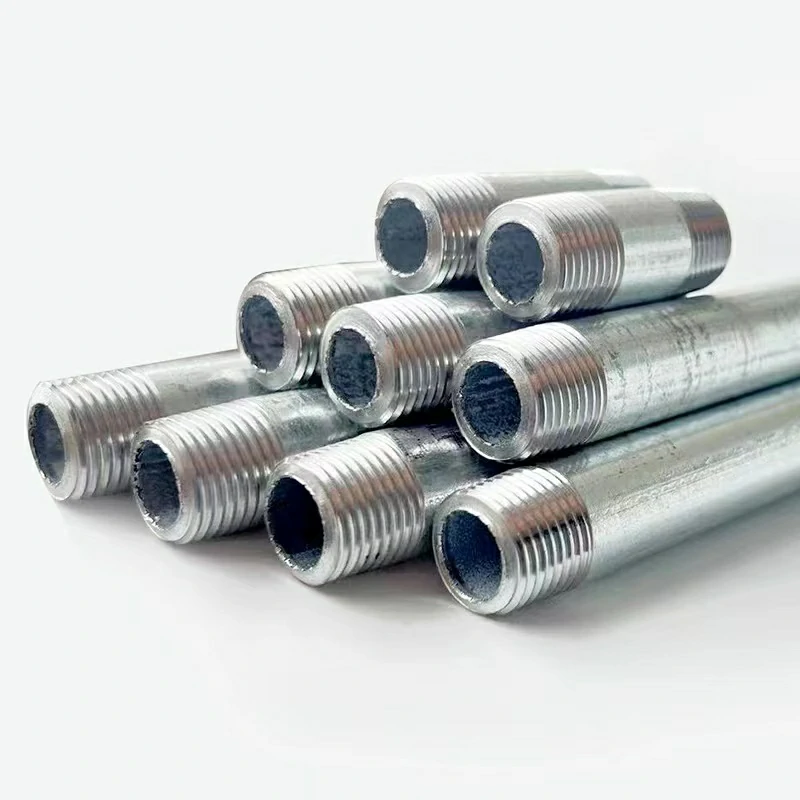In plumbing and piping, a nipple is a fitting that consists of a short piece of pipe. It is usually provided with male pipe threads at both ends. The main function of a nipple is to link two fittings or pipes together. Threaded pipe nipples act as connectors, facilitating the passage of water or other liquids between the joined pipes. They find widespread application in low-pressure piping setups.
Common Materials Used For Threaded Pipe Nipples
- Stainless Steel: Alloys like 304 and 316 offer excellent corrosion resistance for potable water and chemicals. Stainless steel is a popular choice due to its durability and hygienic properties.
- Carbon Steel: Carbon steel is an economical material with good temperature resistance. It is commonly used in steam lines and oil pipelines.
- Red Brass: Red brass provides higher corrosion resistance compared to carbon steel. It can handle exposure to salt air and water effectively.
- Chrome-Moly Steel: Chrome-moly steel exhibits extremely high strength (up to 20,000 psi). It is commonly used in hydraulic systems.
Key Points About Pipe Nipples
Types of Pipe Nipples:
- Close Nipple: This type has very little unthreaded pipe between the two threaded ends. When connected fittings come close to touching each other, it’s called a close nipple or a running nipple.
- Hexagonal Nipple: A hexagonal section in the middle allows it to be gripped by a normal wrench, providing better mechanical advantage than a rounded pipe.
- Long Hex Nipple: Similar to a hexagonal nipple but with more distance between the threaded ends.
- Reducing Nipple (Unequal Nipple): Used for changing pipe dimensions, connecting a larger female fitting to a smaller one.
Installation and Challenges:
Dealing with close nipples can be a bit tricky because when you unscrew them, you have to grip onto the threaded part tightly, risking damage to the threads. To avoid this, plumbers often rely on an internal pipe wrench, also called a “nipple wrench,” to securely hold close nipples in place without causing any harm to the threads.

How to Choose the Right Size?
When selecting the appropriate threaded nipple pipe fitting for your plumbing project, consider the following factors:
Pipe Material and Type:
- Determine the type of pipe you are working with (e.g., copper, PVC, galvanized steel).
- Ensure that the nipple material matches the pipe material to prevent corrosion or leaks.
Threaded Pipe Nipple Dimensions:
- The diameter of the pipe (often referred to as the nominal size) is crucial.
- Measure the inner diameter (ID) of the pipe to determine the correct nipple size.
- Common sizes include 1/2″, 3/4″, 1″, and 1 1/4″.
Length:
- Consider the distance between the two fittings you need to connect.
- Choose a nipple length that allows for proper alignment without excess protrusion.
- Longer nipples provide more flexibility in positioning.
Thread Type:
- Ensure the pipe has male threads at pipe nipple threaded one end for both ends.
- Match the thread type (e.g., NPT, BSP) with the existing fittings or pipes.
Application and Pressure Rating:
- Think about the particular job you’re doing—whether it’s supplying water, managing a gas line, or handling drainage. Make sure to check the pressure rating of the nipple to confirm it’s up to handling the flow and pressure you need. Consider whether tapered or straight threads are best for your situation.
- Tapered threads (NPT) create a tight seal when tightened.
- Straight threads (BSP) require additional sealing material (like Teflon tape or pipe dope).
Material Coating:
Some nipples come with a coating (e.g., galvanized, black iron) for added protection against rust and corrosion.
